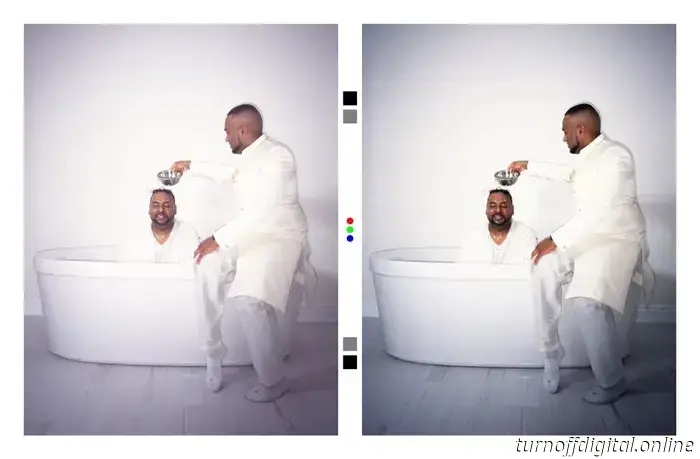
Provia 400F, expired in 2006, shows a shift towards purple (left) and has been corrected (right). This guide will demonstrate how to process your expired slide film scans to resemble their original intent, using two methods: automatic (with film Q) and manual (using any photo-editing software). Film Q allows you to batch process numerous scans with a single click, and you can monitor progress from any internet-connected device. The app employs a basic computer vision technique that can also be manually replicated using free image editing applications like Gimp and well-known tools such as Adobe Photoshop. In this guide, you will find: the quickest, simplest way to enhance expired slide film scans in bulk; how histogram stretching can "correct" expired film scans; when to apply this method; when to avoid this method; and how to address more significant issues with slide film colors. Support this blog and access premium features with GOLD memberships! Kodak Ektachrome 200, expired in 1994, exhibits a shift towards brown (left) and has been corrected (right).
The quickest, simplest way to improve expired slide film scans in bulk. Expired slide film frequently exhibits color shifts towards brown, purple, or blue. While some may appreciate these altered colors, they do not reflect the original emulsions' intended appearance. You can restore the color balance of your slides using film Q: connect your Dropbox account, navigate to Settings, select "Fix Base Fog," and then click or tap “Fix” to process all your files simultaneously, requiring no additional input from you. Film Q automatically corrects the color shifts, returning your images to how they would appear if the film were fresh.
Batch processing of expired film scans' colors can be done with the press of a button using film Q. ✪ Note: The automatic fixes for color shifts may not be suitable for all films. Extremely old emulsions (more than 30 years expired), those that have been incorrectly exposed or developed, or poorly scanned images might require further manual adjustments or may not work at all.
How histogram stretching can "repair" expired film scans. As color film ages, chemical changes can cause color drift; for example, shadows on certain emulsions may turn brown and lack contrast. Additionally, the film base, which should be transparent, can become fogged as radiation gradually seeps through the light seals, causing it to take on a grey tint or a mix of colors, resulting in lackluster highlights. Histogram stretching (normalization) consists of filling the color space with histogram values so that the darkest and lightest pixels reach their respective minimum and maximum values without gaps.
Histogram stretching is an elementary computer vision method that optimizes contrast by adjusting each color channel to ensure the darkest point is black and the brightest is white. Once the color channels are combined, your scans can exhibit significant clarity, rectifying the brown or discolored shadows and dull highlights to appear as if they were brand new. For histogram stretching to function, you must adjust each color channel individually and ensure that the histogram focuses on the relevant parts of your image (i.e., cropping out borders). With manual tools like Adobe Photoshop, you can do this by cropping the image, applying a Curves layer, and shifting the min/max positions for each channel closer to where the histogram starts or ends.
The graphics illustrate the workflow in Photoshop, which should be comparable in most other image editing software, including free options like Gimp and Darktable: Inverting film negatives in Adobe Photoshop with histogram stretching utilizing individual color channels within the Curves Adjustment Layer. You can learn more about the histogram stretching method here. Film Q applies other computer vision techniques to automatically identify your frame borders and exclude them from calculations. While processing your photos, it generates smaller versions of the images with additional adjustments to determine the min/max positions for each channel, then recombines the entire image into an uncompressed file with the original borders intact.
When to use this technique. Histogram stretching should enhance the contrast and clarity of your scans in most instances. You can apply it to renew your expired slide film scans, expired negatives, and black-and-white film scans. It will work with all image formats as long as you can open them. If you want to fix multiple rolls of scanned film simultaneously, film Q can handle it automatically in the cloud, using no resources on your device (and it will operate on any internet-connected device).
Provia 400X, expired in 2013, shows a shift towards blue (left) and has been corrected (right). When not to use this technique. Histogram stretching will not address severe color drifts and issues where contrast and dyes have deteriorated completely. It may be ineffective if the scans have been previously adjusted using other methods in specific ways.
Finally, you may also enjoy the low-contrast appearance and color shifts in your scans; in that case, there's no need for any adjustments. How to address
This guide will demonstrate how to process your expired slide film scans to achieve their original intended appearance, utilizing two methods: automatic (with film Q) and manual (with any photo-editing application).